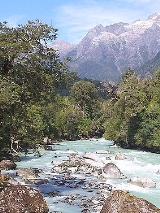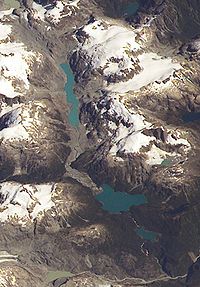
Hornopirén National Park
Encyclopedia
Hornopirén National Park is located in the Andes
, in the Palena Province
of Chile
's Los Lagos Region
. The park contains 482 sqkm of rugged mountains and unspoiled Valdivian temperate rain forests
. This national park borders the northern portion of Pumalín Park
. The Carretera Austral
passes close to the park. In the vicinity of the park lie Hornopirén
and Yate
volcanoes.
The three main bodies of water in the park are Pinto Concha Lake 4.75 sqkm, Cabro Lake 1.55 sqkm and Inexplorado Lake 1.5 sqkm. They are surrounded totally or partially by millennial Alerce
forests. Inexplorado Lake is one of a series of paternoster lake
s that form part of the Blanco River drainage basin. The aforesaid lakes are characterized by distinctive blue and green hues, due to rock flour
suspended in their waters and give to the river its milky appearance. Negro River is another major river system in the park.
, Lesser Grison
, Chilla Fox, American mink
, Coypu
, Pudú
and Chilean Huemul.
It includes Fitzroya trees almost in pure stands. The pristine alerce forests cover an area of about 97.41 sqkm, which comprises approximately the 35 percent of the vegetation cover of the park.

Andes
The Andes is the world's longest continental mountain range. It is a continual range of highlands along the western coast of South America. This range is about long, about to wide , and of an average height of about .Along its length, the Andes is split into several ranges, which are separated...
, in the Palena Province
Palena Province
Palena Province is one of the four provinces in the southern Chilean region of Los Lagos . Due to the eruption of Chaitén Volcano and the subsequent destruction of Chaitén, Futaleufú is since March 2009 the new capital of Palena Province. The private Pumalín Park is located in the province as is...
of Chile
Chile
Chile ,officially the Republic of Chile , is a country in South America occupying a long, narrow coastal strip between the Andes mountains to the east and the Pacific Ocean to the west. It borders Peru to the north, Bolivia to the northeast, Argentina to the east, and the Drake Passage in the far...
's Los Lagos Region
Los Lagos Region
Los Lagos Region is one of Chile's 15 regions, which are first order administrative divisions, and comprises four provinces: Chiloé, Llanquihue, Osorno and Palena. The region contains the country's second largest island, Chiloé, and the second largest lake, Llanquihue.Its capital is Puerto Montt;...
. The park contains 482 sqkm of rugged mountains and unspoiled Valdivian temperate rain forests
Valdivian temperate rain forests
The Valdivian temperate rain forests are a temperate broadleaf and mixed-forest ecoregion located on the west coast of southern South America, lying mostly in Chile and extending into a small part of Argentina. It is part of the Neotropic ecozone. The forests are named after the city of Valdivia...
. This national park borders the northern portion of Pumalín Park
Pumalín Park
Pumalín Park is a private nature reserve in the Palena Province of Chile, created by the United States environmental foundation The Conservation Land Trust, which is endowed and led by the American business magnate Douglas Tompkins...
. The Carretera Austral
Carretera Austral
The Carretera Austral , formerly known as Carretera General Augusto Pinochet, is the name given to Chile's Route 7. The highway runs about from Puerto Montt to Villa O'Higgins through rural Patagonia....
passes close to the park. In the vicinity of the park lie Hornopirén
Hornopirén (volcano)
Hornopirén is a stratovolcano located in the Andes, in Los Lagos Region of Chile, south of Yate Volcano and east of Apagado or Hualiaque pyroclastic cone. Hornopirén lies on the major regional Liquine-Ofqui Fault. The volcano is said to have erupted in 1835, although no details are known...
and Yate
Yate (volcano)
Yate Volcano is a large, glaciated stratovolcano located in the southern Andes, in the Los Lagos Region of Chile, south of the Reloncaví Estuary...
volcanoes.
Geography
The park is dominated by glacier-carved mountains and active volcanoes. It includes glaciers comprising an area of 30 sqkm.The three main bodies of water in the park are Pinto Concha Lake 4.75 sqkm, Cabro Lake 1.55 sqkm and Inexplorado Lake 1.5 sqkm. They are surrounded totally or partially by millennial Alerce
Fitzroya
Fitzroya is a monotypic genus in the cypress family.-Species:The single living species, Fitzroya cupressoides, is a tall, long-lived conifer native to the Andes mountains of southern Chile and Argentina, where it is an important member of the Valdivian temperate rain forests...
forests. Inexplorado Lake is one of a series of paternoster lake
Paternoster lake
A Paternoster lake is one of a series of glacial lakes connected by a single stream or a braided stream system. The name comes from the word Paternoster, another name for the Lord's Prayer derived from the Latin words for the prayer's opening words, "Our Father"; Paternoster lakes are so called...
s that form part of the Blanco River drainage basin. The aforesaid lakes are characterized by distinctive blue and green hues, due to rock flour
Rock flour
Rock flour, or glacial flour, consists of fine-grained, silt-sized particles of rock, generated by mechanical grinding of bedrock by glacial erosion or by artificial grinding to a similar size...
suspended in their waters and give to the river its milky appearance. Negro River is another major river system in the park.
Biology
The park has about 25 mammal species, including native as well as exotic species. Among them are the cougar, KodkodKodkod
The Kodkod , also called Guiña, is the smallest cat in the Americas and also has the smallest distribution, being found primarily in central and southern Chile and marginally in adjoining areas of Argentina...
, Lesser Grison
Lesser Grison
The lesser grison , Galictis cuja, is a mammal species of the ferret family Mustelidae from South America. It is found in Argentina, Bolivia, Brazil, Chile, Paraguay, Peru, and Uruguay....
, Chilla Fox, American mink
American Mink
The American mink is a semi-aquatic species of Mustelid native to North America, though human intervention has expanded its range to many parts of Europe and South America. Because of this, it is classed as Least Concern by the IUCN. Since the extinction of the sea mink, the American mink is the...
, Coypu
Coypu
The coypu , , also known as the river rat, and nutria, is a large, herbivorous, semiaquatic rodent and the only member of the family Myocastoridae. Originally native to subtropical and temperate South America, it has since been introduced to North America, Europe, Asia, and Africa, primarily by...
, Pudú
Pudú
The pudús are two species of South American deer from the genus Pudu; the world's smallest deer. The name is a loanword from Mapudungun the language of the indigenous Mapuche people of southern Chile...
and Chilean Huemul.
It includes Fitzroya trees almost in pure stands. The pristine alerce forests cover an area of about 97.41 sqkm, which comprises approximately the 35 percent of the vegetation cover of the park.


